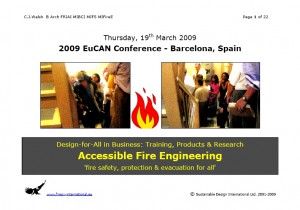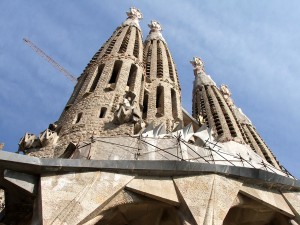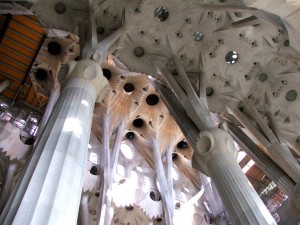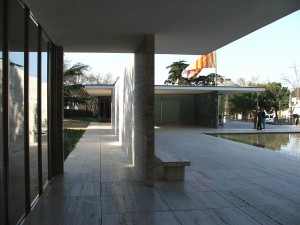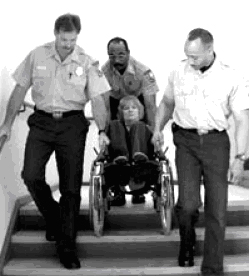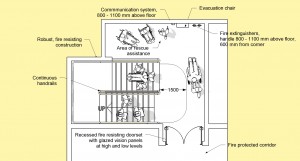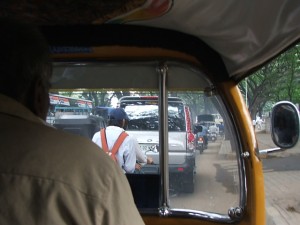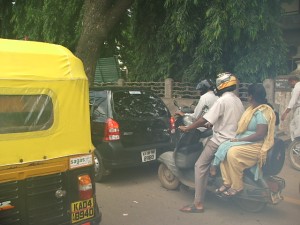2009-03-31: ‘Sustainable’ … ‘Sustainability’ … ‘Sustainable Development’ … what’s all this about ? … and where to begin ?
Words much abused … not only in English … but definitely in French !
Words much confused … for example, in the USA … where ‘Sustainable’ and ‘Green’ can be interchanged in the same conversation without apparent rhyme or reason. Is there a difference between the two ? Some people don’t want to admit that there is … those working in the Green Building Council … or those peddling the LEED Environmental Building Rating System around the more economically advanced developing countries in the world. In India … you can find a ‘LEED’ Building, minimally adapted to local conditions and having used many imported products and systems in its construction (from you-know-where !) … sitting prettily in the neighbourhood of a slum.
In Ireland … remember the good old days, 12-18 months ago … when Economists could afford (?!?) to talk about ‘Sustainable Economic Development’ … did they really mean economic development which is compatible with sustainable development ? No, they didn’t !
Is there any level of awareness amongst our Politicians ? In the National Development Plan (2007-2013), Mr. Brian Cowan T.D., then Minister for Finance, wrote in a January 2007 Foreword to the Plan …
” This National Development Plan is about the future of those young people, their parents, and their grandparents. It establishes a blueprint for the economic and social development of this island for future generations.
In this Plan, we have a unique window of opportunity to get it right: in terms of spatial planning, support infrastructure, environmental sustainability and economic growth.”
… an unusual limitation on the use and context for the word ‘sustainability’ … which should now also be exhibited in the National Gallery of Art !?!
Some Organizations openly state that they are dealing with … or they will only be dealing with … environmental aspects of sustainable development. That is a silly waste of time … and counterproductive !
Properly Defining Sustainable Development
Let us quickly re-wind back to the end of the 20th Century …
… not as far back as the Stockholm Declaration of the United Nations Conference on the Human Environment, which met in Sweden, from 5-16th June 1972 … which, for us, was a very interesting exercise …
… but to the 1987 Report of the World Commission on Environment and Development (WCED), which was chaired by Gro Harlem Brundtland (Norway). Mansour Khalid (Sudan) was Vice-Chair of the Commission.
The definition of ‘Sustainable Development’ appears at the beginning of Chapter 2 …
” Sustainable Development is development that meets the needs of the present without compromising the ability of future generations to meet their own needs. It contains within it two key concepts:
– the concept of ‘needs’, in particular the essential needs of the world’s poor, to which overriding priority should be given ; and
– the idea of limitations imposed by the state of technology and social organization on the environment’s ability to meet present and future needs.”
Many readers may only be familiar with the first sentence above but, in isolation, that leaves the definition of ‘sustainable development’ so vague that it is almost meaningless. And let us be clear in our own minds … an ambiguous definition will continue to be rejected by the Developing and Least Developed Regions of the World … the concept being viewed as an unaffordable luxury and/or a means of continued domination and control by the ‘North’.
Other readers may be surprised by the second, and more important, half of the WCED/Brundtland Definition. It is clear, however, that it was always intended that there would be more than 3 Aspects of Sustainable Development … Environmental, Social and Economic … to be identified and examined. How, on this Earth, was it possible for anybody to ever bring into existence that clumsy 3-Circle Diagram ???
The 1987 WCED/Brundtland Report continues a little further on …
” The satisfaction of human needs and aspirations is the major objective of development. The essential needs of vast numbers of people in developing countries – for food, clothing, shelter, jobs – are not being met, and beyond their basic needs these people have legitimate aspirations for an improved quality of life. A world in which poverty and inequity are endemic will always be prone to ecological and other crises. Sustainable Development requires meeting the basic needs of all and extending to all the opportunity to satisfy their aspirations for a better life.”
Sustainable Development is the greatest challenge ahead of us in this 21st Century. It remains very much an intricate, open, dynamic and evolving concept …
… and a clear choice must be made: decide to pursue the detailed elaboration of this concept … either with the aim of practical implementation … or of intellectual masturbation.
We made that choice many years ago … back in the mid-1990’s.
Practical Implementation of Sustainable Human & Social Development
In order to make any ‘real’ progress … how can we establish, agree upon and achieve a wide international consensus on what the ‘basic needs of all’ are … and with some precision ?
Is there an internationally recognized document, already long in existence, where these ‘basic needs’ are not only specified for all people, but are protected and guaranteed ?
Yes, indeed there is … the 1948 Universal Declaration of Human Rights (UN OHCHR) … and these needs, therefore, can also be described as being ‘responsible’.
Reading through the 1948 UDHR, it might be helpful if a distinction is made between human rights and social rights …
Social Rights:
Rights to which an individual person is legally entitled, e.g. the right to free elementary education (Art.26(1), UDHR), but which are only exercised in a social context with other people, and with the active support of a competent legal authority, e.g. a Nation State.
Commentary: In contrast to Human Rights, it is not protection from the State which is desired or achieved, but freedom with the State’s help.
Social Rights, as distinguished here, include and extend beyond current understandings of civil, political, economic, social and cultural rights.
This is why, almost a generation after the 1987 WCED/Brundtland Definition of Sustainable Development …
… Sustainable Design International, has defined Sustainable Human & Social Development as follows …
Development which meets the responsible needs, i.e. the Human & Social Rights*, of this generation – without stealing the life and living resources from future generations, especially our children … and their children.
* As defined in the 1948 Universal Declaration of Human Rights (UN OHCHR).
Furthermore … for a sizeable group of people in all of our societies, the sole route of access to the human and social rights set down in the 1948 Universal Declaration of Human Rights … is the 2006 UN Convention on the Rights of Persons with Disabilities … which became an International Legal Instrument on 3rd May 2008 … just short of 60 Years after the UDHR was adopted on 10th December 1948 !
A 3rd International Instrument to be placed at the top of this Framework of Basic & Responsible Needs, i.e. Rights … is the 2001 Universal Declaration on Cultural Diversity (UNESCO) … adopted in Paris, on 2nd November 2001 … and which came into being shortly after the World Trade Center (9-11) Incident in New York, on 11th September 2001.
The Universal Declaration on Cultural Diversity raises cultural diversity to the level of the common heritage of humanity … as necessary for humankind as biodiversity is for nature … and makes its defence an ethical imperative which is robustly linked to, and cannot be separated from, respect for the dignity of each individual person.
Paris, at the end of 2001, presented the world with a valuable opportunity …
– to reaffirm the unshakable conviction that intercultural dialogue is the best guarantee of peace ; and
– to reject outright the theory of the inevitable clash of cultures and civilizations.
So … once it is possible to construct an initial, robust framework of International Human & Social Rights Instruments … specifying the ‘basic needs of all’ … which underpins and cuts down to the core of a far more elaborate and hard-edged, 2nd Generation Definition of Sustainable Human & Social Development …
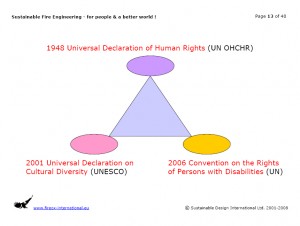
… we can roll out the ‘Sustainability’ Agenda … and begin the serious task of transforming our Human Environment (see a previous post) by gradually improving and monitoring ‘real’ Sustainability Performance … using …
– Sustainability Impact Assessment (SIA) … see a previous post ;
and
– Performance Indicators ;
– Target Setting ;
– Benchmarking ;
– Performance Evaluation & Independent Verification ;
– Etc.
.
.
END

